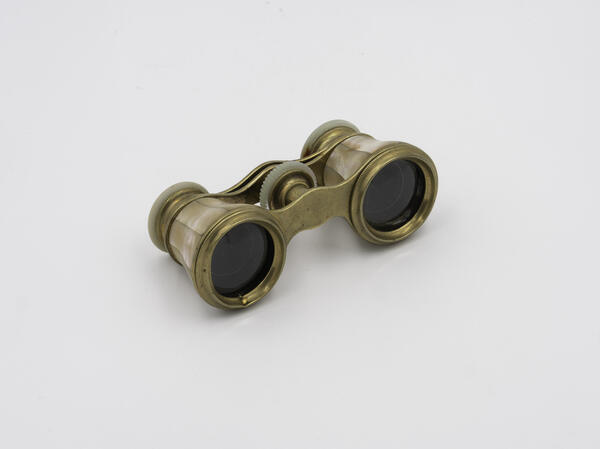The museum collection includes opera glasses of the late 19th century. Such opera glasses were invented at the beginning of the 18th century to make viewing a theatrical performance more comfortable. However, they were not popular at first, because the technology at the time was not perfect.
The first opera glasses appeared in 1756 in Vienna. They were created by an optician and inventor named Christoph Fochlander, who founded a family business specializing in optics and mechanics. In 1823, the opera glasses went on sale for the first time.
During the same period, their popularity among fans of theatrical art also increased. ‘A bunch of violets, an embroidered kerchief, large opera glasses, and a bottle of snuff — these are the four things that a fashionable lady needs to have in the theater, ’ wrote the Journal des dames et des modes in 1823.
However, the first optical devices were far from ideal and were quite expensive: opera glasses often distorted the image of the action taking place on the theater stage. This problem was eventually solved, but only upon several years, when new lenses and prisms, which were invented by the German physicist Ernst Abbe, were introduced into production.
The invention was considered unique at that time. Such lenses perfectly adjusted the image, made it clearer, closed in on the picture on the stage, and did not require the binocular body to be constantly extended in length. In the 19th century, opera glasses were considered the most accurate. They were richly decorated: covered with silver, gold; inserts of mother-of-pearl and ivory were added.
The fashion for opera glasses came to Russia in the 19th century. During this period, there were several stores of optical devices in St. Petersburg, which specialized, among other things, in products for the theater. At the same time, the Russian Empire did not produce optical devices in sufficient quantity to meet all market needs. It was only at the end of the 19th century that such large domestic manufacturers as the firm of Ivan Yakovlevich Urlaub in St. Petersburg were able to provide consumers with devices that were adequate for the time. And in 1896, when an industrial and art exhibition was held in Nizhny Novgorod, the company of Ivan Urlaub was awarded a gold medal ‘For the impeccable polishing of optical lentils and the production of opera glasses’ (The optical lens is named after the lentil (Latin: lens), whose shape it resembles).
Over time, opera glasses began to be used not only for observing performances. They also come in handy at other entertaining events, whether it is sports competitions or circus performances. The main feature of the opera glasses is their small size: they are compact, lightweight, and beautiful.
The first opera glasses appeared in 1756 in Vienna. They were created by an optician and inventor named Christoph Fochlander, who founded a family business specializing in optics and mechanics. In 1823, the opera glasses went on sale for the first time.
During the same period, their popularity among fans of theatrical art also increased. ‘A bunch of violets, an embroidered kerchief, large opera glasses, and a bottle of snuff — these are the four things that a fashionable lady needs to have in the theater, ’ wrote the Journal des dames et des modes in 1823.
However, the first optical devices were far from ideal and were quite expensive: opera glasses often distorted the image of the action taking place on the theater stage. This problem was eventually solved, but only upon several years, when new lenses and prisms, which were invented by the German physicist Ernst Abbe, were introduced into production.
The invention was considered unique at that time. Such lenses perfectly adjusted the image, made it clearer, closed in on the picture on the stage, and did not require the binocular body to be constantly extended in length. In the 19th century, opera glasses were considered the most accurate. They were richly decorated: covered with silver, gold; inserts of mother-of-pearl and ivory were added.
The fashion for opera glasses came to Russia in the 19th century. During this period, there were several stores of optical devices in St. Petersburg, which specialized, among other things, in products for the theater. At the same time, the Russian Empire did not produce optical devices in sufficient quantity to meet all market needs. It was only at the end of the 19th century that such large domestic manufacturers as the firm of Ivan Yakovlevich Urlaub in St. Petersburg were able to provide consumers with devices that were adequate for the time. And in 1896, when an industrial and art exhibition was held in Nizhny Novgorod, the company of Ivan Urlaub was awarded a gold medal ‘For the impeccable polishing of optical lentils and the production of opera glasses’ (The optical lens is named after the lentil (Latin: lens), whose shape it resembles).
Over time, opera glasses began to be used not only for observing performances. They also come in handy at other entertaining events, whether it is sports competitions or circus performances. The main feature of the opera glasses is their small size: they are compact, lightweight, and beautiful.


